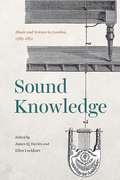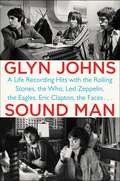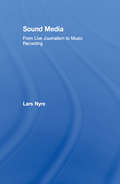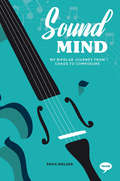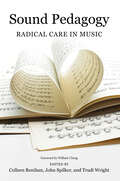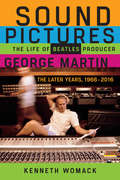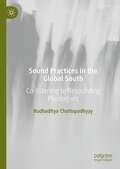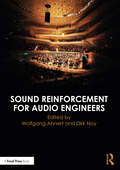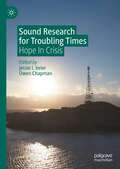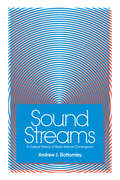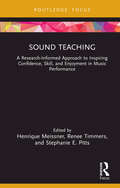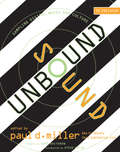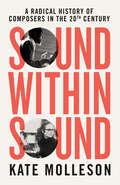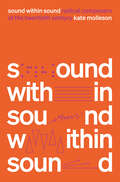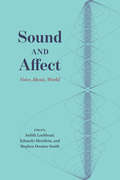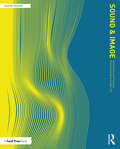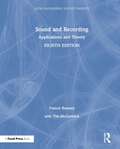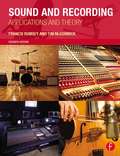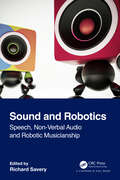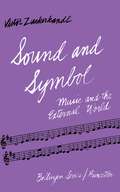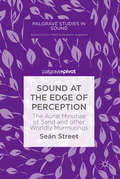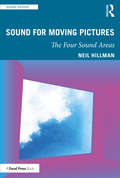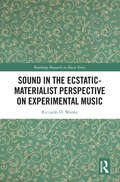- Table View
- List View
Sound Knowledge: Music and Science in London, 1789-1851
by James Q. Davies Ellen LockhartWhat does it mean to hear scientifically? What does it mean to see musically? This volume uncovers a new side to the long nineteenth century in London, a hidden history in which virtuosic musical entertainment and scientific discovery intersected in remarkable ways. Sound Knowledge examines how scientific truth was accrued by means of visual and aural experience, and, in turn, how musical knowledge was located in relation to empirical scientific practice. James Q. Davies and Ellen Lockhart gather work by leading scholars to explore a crucial sixty-year period, beginning with Charles Burney’s ambitious General History of Music, a four-volume study of music around the globe, and extending to the Great Exhibition of 1851, where musical instruments were assembled alongside the technologies of science and industry in the immense glass-encased collections of the Crystal Palace. Importantly, as the contributions show, both the power of science and the power of music relied on performance, spectacle, and experiment. Ultimately, this volume sets the stage for a new picture of modern disciplinarity, shining light on an era before the division of aural and visual knowledge.
Sound Man
by Glyn JohnsBorn just outside London in 1942, Glyn Johns was sixteen years old at the dawn of rock and roll. His big break as a producer came on the Steve Miller Band's debut album, Children of the Future, and he went on to engineer or produce iconic albums for the best in the business: Abbey Road with the Beatles, Led Zeppelin's and the Eagles' debuts, Who's Next by the Who, and many others. Even more impressive, Johns was perhaps the only person on a given day in the studio who was entirely sober, and so he is one of the most reliable and clear-eyed insiders to tell these stories today. In this entertaining and observant memoir, Johns takes us on a tour of his world during the heady years of the sixties, with beguiling stories that will delight music fans the world over: he remembers helping to get the Steve Miller Band released from jail shortly after their arrival in London, he recalls his impressions of John and Yoko during the Let It Be sessions, and he recounts running into Bob Dylan at JFK and being asked to work on a collaborative album with him, the Stones, and the Beatles, which never came to pass. Johns was there during some of the most iconic moments in rock history, including the Stones' first European tour, Jimi Hendrix's appearance at Albert Hall in London, and the Beatles' final performance on the roof of their Savile Row recording studio. Johns's career has been long and prolific, and he's still at it--over the last two decades he has worked with Crosby, Stills & Nash; Emmylou Harris; Linda Ronstadt; Band of Horses; and, most recently, Ryan Adams. Sound Man provides a firsthand glimpse into the art of making music and reveals how the industry--like musicians themselves--has changed since those freewheeling first years of rock and roll.
Sound Man
by Glyn JohnsBorn just outside London in 1942, Glyn Johns was sixteen years old at the dawn of rock and roll. His big break as a producer came on the Steve Miller Band's debut album, Children of the Future, and he went on to engineer or produce iconic albums for the best in the business: Abbey Road with the Beatles, Led Zeppelin's and the Eagles' debuts, Who's Next by the Who, and many others. Even more impressive, Johns was perhaps the only person on a given day in the studio who was entirely sober, and so he is one of the most reliable and clear-eyed insiders to tell these stories today.In this entertaining and observant memoir, Johns takes us on a tour of his world during the heady years of the sixties, with beguiling stories that will delight music fans the world over: he remembers helping to get the Steve Miller Band released from jail shortly after their arrival in London, he recalls his impressions of John and Yoko during the Let It Be sessions, and he recounts running into Bob Dylan at JFK and being asked to work on a collaborative album with him, the Stones, and the Beatles, which never came to pass. Johns was there during some of the most iconic moments in rock history, including the Stones' first European tour, Jimi Hendrix's appearance at Albert Hall in London, and the Beatles' final performance on the roof of their Savile Row recording studio.Johns's career has been long and prolific, and he's still at it--over the last two decades he has worked with Crosby, Stills & Nash; Emmylou Harris; Linda Ronstadt; Band of Horses; and, most recently, Ryan Adams. Sound Man provides a firsthand glimpse into the art of making music and reveals how the industry--like musicians themselves--has changed since those freewheeling first years of rock and roll.
Sound Media: From Live Journalism to Music Recording
by Lars NyreSound Media considers how music recording, radio broadcasting and muzak influence people's daily lives and introduces the many and varied creative techniques that have developed in music and journalism throughout the twentieth century. Lars Nyre starts with the contemporary cultures of sound media, and works back to the archaic soundscapes of the 1870s. The first part of the book devotes five chapters to contemporary digital media, and presents the internet, the personal computer, digital radio (news and talk) and various types of loudspeaker media (muzak, DJ-ing, clubbing and PA systems). The second part examines the historical accumulation of techniques and sounds in sound media, and presents multitrack music in the 1960s, the golden age of radio in the 1950s and back to the 1930s, microphone recording of music in the 1930s, the experimental phase of wireless radio in the 1910s and 1900s, and the invention of the gramophone and phonograph in the late nineteenth century. Sound Media includes a soundtrack CD with thirty-six examples from broadcasting and music recording in Europe and the USA, from Edith Piaf to Sarah Cox, and is richly illustrated with figures, timelines and technical drawings.
Sound Mind: My Bipolar Journey From Chaos to Composure (Inspirational Series)
by Erika NielsenErika Nielsen knew that her real language was music - her truest voice, the cello - by the time she was three years old. She knew she would become a professional musician by the eighth grade. But she could never understand why sometimes she felt as if she was floating on sparkling clouds, enchanted by her own brilliance, while at other times she huddled in a dark, wretched place, sobbing and overcome with her inadequacy. At age 27, she finally found out: she was mentally ill.Containing wellness tips and coping strategies to live creatively, productively, and healthily with a mental illness, Sound Mind is a story of hope, healing, and transformation that reminds us that it is not only possible to function with a mental illness, it is possible to thrive. By promoting education, awareness and de-stigmatization of mental illness, Sound Mind helps write a new narrative around mental health and wellness.
Sound Pedagogy: Radical Care in Music (Music in American Life)
by Mark Katz Stephanie Jensen-Moulton Mary Natvig Sara Haefeli William Everett Colleen Renihan Molly M Breckling Kate Galloway Eric Hung Nathan A Langfitt Matteo Magarotto Frederick A Peterbark Laura Moore Pruett Amanda Christina Soto John Spilker Reba A Wissner Trudi WrightMusic education today requires an approach rooted in care and kindness that coexists alongside the dismantling of systems that fail to serve our communities in higher education. But, as the essayists in Sound Pedagogy show, the structural aspects of music study in higher education present obstacles to caring and kindness like the entrenched master-student model, a neoliberal individualist and competitive mindset, and classical music’s white patriarchal roots. The editors of this volume curate essays that use a broad definition of care pedagogy, one informed by interdisciplinary scholarship and aimed at providing practical strategies for bringing transformative learning and engaged pedagogies to music classrooms. The contributors draw from personal experience to address issues including radical kindness through universal design; listening to non-human musicality; public musicology as a forum for social justice discourse; and radical approaches to teaching about race through music. Contributors: Molly M. Breckling, William A. Everett, Kate Galloway, Sara Haefeli, Eric Hung, Stephanie Jensen-Moulton, Mark Katz, Nathan A. Langfitt, Matteo Magarotto, Mary Natvig, Frederick A. Peterbark, Laura Moore Pruett, Colleen Renihan, Amanda Christina Soto, John Spilker, Reba A. Wissner, and Trudi Wright
Sound Pictures: The Life of Beatles Producer George Martin, The Later Years, 1966–2016
by Kenneth WomackMore than anyone besides the bandmates themselves, George Martin was the man who created the unique sound of the Beatles. Sound Pictures offers a powerful and intimate account of how he did so. The second and final volume of the definitive biography of the man, Sound Pictures traces the story of the Beatles' breathtaking artistic trajectory after reaching the creative heights of Rubber Soul. As the bandmates engage in brash experimentation both inside and outside the studio, Martin toils along with manager Brian Epstein to consolidate the Beatles' fame in the face of growing sociocultural pressures, including the crisis associated with the "Beatles are more popular than Jesus" scandal. Meanwhile, he also struggles to make his way as an independent producer in the highly competitive world of mid-1960s rock 'n' roll. As Martin and the Beatles create one landmark album after another, including such masterworks as Revolver, Sgt. Pepper's Lonely Hearts Club Band, The Beatles (The White Album), and Abbey Road, the internal stakes and interpersonal challenges become ever greater. During his post-Beatles years, Martin attempts to discover new vistas of sound recording with a host of acts, including Jeff Beck, America, Cheap Trick, Paul McCartney, and Elton John, his creative breakthroughs followed by unprecedented commercial success. Eventually, though, all roads bring Martin back to the Beatles, as the group seeks out new ways to memorialize their achievement under the supervision of the man who has come to be known as Sir George. Now, more than fifty years after the Beatles' revolutionary triumphs, Martin's singular stamp on popular music has become more vital than ever, as successive generations discover the magic of the Beatles and their groundbreaking sound.
Sound Practices in the Global South: Co-listening to Resounding Plurilogues
by Budhaditya ChattopadhyayThis book develops a comprehensive understanding of the unique sound worlds of key regions in the Global South, through an auto-ethnographic method of self-reflective conversations with prominent sound practitioners from South Asia, Africa, the Middle East and Latin America. The conversations navigate various trajectories of sound practices, illuminating intricate sonic processes of listening, thinking through sounds, ideating, exposing, and performing with sound. This collection of conversations constitutes the main body of the book, including critical and scholarly commentaries on aural cultures, sound theory and production. The book builds a ground-up approach to nurturing knowledge about aural cultures and sonic aesthetics, moving beyond the Eurocentric focus of contemporary sound studies. Instead of understanding sound practices through consumption and entertainment, they are explored as complex cultural and aesthetic systems, working directly with the practitioners themselves, who largely contribute to the development of the sonic methodologies. Refocusing on the working methods of practitioners, the book reveals a tension between the West’s predominant colonial-consumerist cultures, and the collective desires of practitioners to resist colonial models of listening by expressing themselves in terms of their arts and craft, and their critical faculties.Conversations with: Clarence Barlow, Sandeep Bhagwati, Rajesh K. Mehta, Sharif Sehnaoui, Ximena Alarcón Díaz, Hardi Kurda, Mario de Vega, Luka Mukhavele, Khyam Allami, Cedrik Fermont, Khaled Kaddal, David Velez, Juan Duarte, Youmna Saba, Abdellah M. Hassak, Mariana Marcassa, Amanda Gutiérrez, Syma Tariq, Alma Laprida, Siamak Anvari, Mohamad Safa, Debashis Sinha, Zouheir Atbane, Constanza Bizraelli, Jatin Vidyarthi, Joseph Kamaru, Surabhi Saraf, Isuru Kumarasinghe, Hemant Sreekumar.
Sound Reinforcement for Audio Engineers
by Wolfgang AhnertSound Reinforcement for Audio Engineers illustrates the current state of the art in sound reinforcement. Beginning with an outline of various fields of applications, from sports venues to religious venues, corporate environments and cinemas, this book is split into 11 chapters covering room acoustics, loudspeakers, microphones and acoustic modelling among many other topics. This comprehensive book packed with references and a historical overview of sound reinforcement design is an essential reference book for students of acoustics and electrical engineering, but also for engineers looking to expand their knowledge of designing sound reinforcement systems.
Sound Research for Troubling Times: Hope In Crisis
by Jessie L. Beier Owen ChapmanThis edited collection takes the prompt “hope in crisis” as a starting point for investigating sound research as it is situated in these troubling times. The book brings together thinkers from numerous scholarly domains (i.e. communication studies, art education, creative art therapy, psychology and philosophy) to explore the question of hope as it relates to sonic research-creation practices in/and times of crisis. Some of the prompts and provocations explored by the authors within the collection include, but are not limited to: explorations of sonic research-creation practices as they are situated within contemporary convergence of crises; theoretical investigations of the concept of hope as it relates to sonic temporalities, ontologies, and epistemologies; articulations of experimental sonic pedagogies; examinations of hope as it plays out in institutional settings and/or sound and music scenes (i.e. music education, artistic communities, activist communities); investigations of experimental listening practices as they relate to contemporary crises; explorations of post-human, non-human, and inhuman sonic resonances in research-creation practices; and experimental practices that deploy sound and sonic approaches for emergent, collective research both within, but also outside of, academic institutions. Positioned as a material that holds the potential to frustrate common approaches to research, whether through its refusal of occularcentric perspectives, its leaky data protocols or its distortion of future horizons, sound is explored here as that which might counter the default refrains that have pushed hope itself into crisis. Importantly, while sound research is explored in this book in relation to hope, it is not offered up as a better way forward, nor is it presented as a solution. Sound research is instead posed as a question, with each author responding in their own way through experiments with the potentials, but also limits, of and for sonic practices. Central to the project, then, is the question of how to collectively and creatively respond to the increasingly difficult— even untenable—circumstances that have come to limit future possibilities, both within fields of research but also beyond, without falling back on the unquestioned assumption that hope alone will actualize a desired otherworld. The sound research gathered here experiments with such possibilities in order to grapple with how present conditions, including conditions for research, are always contingent—always already in trouble—and thus also subject to change both conceptually and materially.
Sound Streams: A Cultural History of Radio-Internet Convergence
by Andrew J BottomleyIn talking about contemporary media, we often use a language of newness, applying words like “revolution” and “disruption.” Yet, the emergence of new sound media technologies and content—from the earliest internet radio broadcasts to the development of algorithmic music services and the origins of podcasting—are not a disruption, but a continuation of the century-long history of radio. Today’s most innovative media makers are reintroducing forms of audio storytelling from radio’s past. Sound Streams is the first book to historicize radio-internet convergence from the early ’90s through the present, demonstrating how so-called new media represent an evolutionary shift that is nevertheless historically consistent with earlier modes of broadcasting. Various iterations of internet radio, from streaming audio to podcasting, are all new radio practices rather than each being a separate new medium: radio is any sound media that is purposefully crafted to be heard by an audience. Rather than a particular set of technologies or textual conventions, web-based broadcasting combines unique practices and features and ideas from radio history. In addition, there exists a distinctive conversationality and reflexivity to radio talk, including a propensity for personal stories and emotional disclosure, that suits networked digital media culture. What media convergence has done is extend and intensify radio’s logics of connectivity and sharing; sonically mediated personal expression intended for public consideration abounds in online media networks. Sound Streams marks a significant contribution to digital media and internet studies. Its mix of cultural history, industry research, and genre and formal analysis, especially of contemporary audio storytelling, will appeal to media scholars, radio and podcast practitioners, audio journalism students, and dedicated podcast fans.
Sound Teaching: A Research-Informed Approach to Inspiring Confidence, Skill, and Enjoyment in Music Performance
by Renee Timmers Stephanie E. Pitts Henrique MeissnerSound Teaching explores the ways in which music psychology and education can meet to inspire developments in the teaching and learning of music performance. The book is based on music practitioners’ research into aspects of their own professional practice. Each chapter addresses a specific topic related to musical communication and expression, performance confidence and enjoyment, or skill development in individual and group learning. It explains the background of the research, outlines main findings, and provides suggestions for practical applications. Sound Teaching provides a research-informed approach to teaching and contributes to music tutors’ professional development in teaching children and adults of various ages and abilities. Sound Teaching is written for vocal and instrumental music teachers, music performers with a portfolio career, and music students at conservatoires and universities. Music students undertaking practice-related research will find examples of research methodologies and projects that are informative for their studies. Musical participants of all kinds – students, teachers, performers, and audiences – will find new ways of understanding their practice and experience through research.
Sound Unbound: Sampling Digital Music and Culture
by Paul D. MillerThe role of sound and digital media in an information-based society: artists—from Steve Reich and Pierre Boulez to Chuck D and Moby—describe their work.If Rhythm Science was about the flow of things, Sound Unbound is about the remix—how music, art, and literature have blurred the lines between what an artist can do and what a composer can create. In Sound Unbound, Rhythm Science author Paul Miller aka DJ Spooky that Subliminal Kid asks artists to describe their work and compositional strategies in their own words. These are reports from the front lines on the role of sound and digital media in an information-based society. The topics are as diverse as the contributors: composer Steve Reich offers a memoir of his life with technology, from tape loops to video opera; Miller himself considers sampling and civilization; novelist Jonathan Lethem writes about appropriation and plagiarism; science fiction writer Bruce Sterling looks at dead media; Ron Eglash examines racial signifiers in electrical engineering; media activist Naeem Mohaiemen explores the influence of Islam on hip hop; rapper Chuck D contributes “Three Pieces”; musician Brian Eno explores the sound and history of bells; Hans Ulrich Obrist and Philippe Parreno interview composer-conductor Pierre Boulez; and much more. “Press 'play,'” Miller writes, “and this anthology says 'here goes.'” The groundbreaking music that accompanies the book features Nam Jun Paik, the Dada Movement, John Cage, Sonic Youth, and many other examples of avant-garde music. Most of this content comes from the archives of Sub Rosa, a legendary record label that has been the benchmark for archival sounds since the beginnings of electronic music. To receive these free music files, readers may send an email to the address listed in the book.ContributorsDavid Allenby, Pierre Boulez, Catherine Corman, Chuck D, Erik Davis, Scott De Lahunta, Manuel DeLanda, Cory Doctorow, Eveline Domnitch, Frances Dyson, Ron Eglash, Brian Eno, Dmitry Gelfand, Dick Hebdige, Lee Hirsch, Vijay Iyer, Ken Jordan, Douglas Kahn, Daphne Keller, Beryl Korot, Jaron Lanier, Joseph Lanza, Jonathan Lethem, Carlo McCormick, Paul D. Miller aka DJ Spooky that Subliminal Kid, Moby, Naeem Mohaiemen, Alondra Nelson, Keith and Mendi Obadike, Hans Ulrich Obrist, Pauline Oliveros, Philippe Parreno, Ibrahim Quaraishi, Steve Reich, Simon Reynolds, Scanner aka Robin Rimbaud, Nadine Robinson, Daniel Bernard Roumain (DBR), Alex Steinweiss, Bruce Sterling, Lucy Walker, Saul Williams, Jeff E. Winner
Sound Within Sound: A Radical History of Composers in the 20th Century
by Kate MollesonA radical and compelling new history of 20th century composers, shining light on the sonic pioneers whose work transformed musical history.The twentieth century was the century of modernity. Classical music flourished, and yet when we reflect on the genre&’s history its central figures seem to share three characteristics: they were white, male and western. Sound Within Sound is the impassioned and exhilarating story of the composers who dared to challenge the conventional world of classical music in the twentieth century. Traversing the globe from Ethiopia and the Philippines to Mexico, Russia and beyond, Kate Molleson tells the stories of ten figures who altered the course of musical history, only to be sidelined and denied recognition during an era that systemically favoured certain sounds – and people – over others.A celebration of radical creativity rooted in ideas of protest, gender, race, ecology and resistance, Sound Within Sound is an energetic reappraisal of twentieth-century classical music that opens up the world far beyond its established centres, challenges stereotypical portrayals of the genre and shatters its traditional canon.
Sound Within Sound: Radical Composers of the Twentieth Century
by Kate MollesonSound Within Sound presents an alternative history of 20th-century composers—nearly all of them women or composers of color—by a leading international music critic. Think of a composer right now. Was it a white man? Perhaps in old-fashioned clothing and wild hair? The music history we’re taught is one dominated by men, and even then, only a select few enter the zeitgeist. This conventional history perpetuates the myth of “great works” created by “genius” artists. Men who enjoyed institutional privilege during their lifetimes and have since been enshrined by an industry of publishers and record labels. But just because we haven’t heard of spectacular female composers doesn’t mean they weren’t creating music all the same. Profiling a dozen pioneering 20th-century composers—including American modernist Ruth Crawford Seeger (mother of Pete and Peggy Seeger), French electronic artist Éliane Radigue, Soviet visionary Galina Ustvolskaya, and Ethiopian pianist Emahoy Tsegué-Maryam Guèbrou—acclaimed journalist and BBC broadcaster Kate Molleson reexamines the canon while bringing to life largely forgotten sonic revolutionaries whose dramatic lives and bursts of creativity played out against a backdrop of seismic geopolitical and social change. These composers, working at a remove from London, Paris, Vienna, and New York, were sidelined and ignored for systemic, structural reasons. This is a landmark alternative history of 20th-century composers; a radical, new, and truly global work of revisionist history. It is a campaigning book that challenges the status quo while introducing you to a world of groundbreaking music. Includes Black-and-White Photographs
Sound and Affect: Voice, Music, World
by Eduardo Mendieta Judith Lochhead Stephen Decatur SmithThere is no place on earth that does not echo with the near or distant sounds of human activity. More than half of humanity lives in cities, meaning the daily soundtrack of our lives is filled with sound—whether it be sonorous, harmonious, melodic, syncopated, discordant, cacophonous, or even screeching. This new anthology aims to explore how humans are placed in certain affective attitudes and dispositions by the music, sounds, and noises that envelop us. ?Sound and Affect maps a new territory for inquiry at the intersection of music, philosophy, affect theory, and sound studies. The essays in this volume consider objects and experiences marked by the correlation of sound and affect, in music and beyond: the voice, as it speaks, stutters, cries, or sings; music, whether vocal, instrumental, or machine-made; and our sonic environments, whether natural or artificial, and how they provoke responses in us. Far from being stable, correlations of sound and affect are influenced and even determined by factors as diverse as race, class, gender, and social and political experience. Examining these factors is key to the project, which gathers contributions from a cross-disciplinary roster of scholars, including both established and new voices. This agenda-setting collection will prove indispensable to anyone interested in innovative approaches to the study of sound and its many intersections with affect and the emotions.
Sound and Image: Aesthetics and Practices (Sound Design)
by Andrew Knight-HillSound and Image: Aesthetics and Practices brings together international artist scholars to explore diverse sound and image practices, applying critical perspectives to interrogate and evaluate both the aesthetics and practices that underpin the audiovisual. Contributions draw upon established discourses in electroacoustic music, media art history, film studies, critical theory and dance; framing and critiquing these arguments within the context of diverse audiovisual practices. The volume’s interdisciplinary perspective contributes to the rich and evolving dialogue surrounding the audiovisual, demonstrating the value and significance of practice-informed theory, and theory derived from practice. The ideas and approaches explored within this book will find application in a wide range of contexts across the whole scope of audiovisuality, from visual music and experimental film, to narrative film and documentary, to live performance, sound design and into sonic art and electroacoustic music. This book is ideal for artists, composers and researchers investigating theoretical positions and compositional practices which bring together sound and image.
Sound and Recording: Applications and Theory (Audio Engineering Society Presents)
by Francis RumseyProviding vital reading for audio students and trainee engineers, Sound and Recording is the essential guide for anyone who wants a solid grounding in both theory and industry practices in audio, sound, and recording. This updated and comprehensively restructured edition includes new content on DAW configuration, effects processing, 3D/immersive audio systems, object-based audio, and VR audio technology. This bestselling book introduces you to the principles of sound, perception, audio technology, and systems. Sound and Recording is the ideal audio engineering text for students, an accessible reference for professionals, and a comprehensive introduction for hobbyists.
Sound and Recording: Applications and Theory (Focal Press Music Technology Ser.)
by Francis Rumsey Tim MccormickProviding vital reading for audio students and trainee engineers, this guide is ideal for anyone who wants a solid grounding in both theory and industry practices in audio, sound and recording. There are many books on the market covering "how to work it" when it comes to audio equipment--but Sound and Recording isn't one of them. Instead, you'll gain an understanding of "how it works" with this approachable guide to audio systems. New to this edition: Digital audio section revised substantially to include the latest developments in audio networking (e.g. RAVENNA, AES X-192, AVB), high-resolution surround and parametric audio coding, workstation processing technology, mastering for iTunes, and loudness normalization Coverage of immersive audio systems such as Dolby Atmos, Auro 3D and WFS along with recent developments in audio object coding Sections on digital radio microphones, loudspeaker sensitivity issues and development, and highly directional loudspeaker systems Substantial new sections on recent developments in audio network device discovery and control and the Open Control Architecture
Sound and Recording: Applications and Theory (ISSN)
by Francis RumseyProviding vital reading for audio students and trainee engineers, Sound and Recording is the essential guide for anyone who wants a solid grounding in both theory and industry practices in audio, sound, and recording. This updated and comprehensively restructured edition includes new content on DAW configuration, effects processing, 3D/immersive audio systems, object-based audio, and VR audio technology.This bestselling book introduces you to the principles of sound, perception, audio technology, and systems. Sound and Recording is the ideal audio engineering text for students, an accessible reference for professionals, and a comprehensive introduction for hobbyists.
Sound and Robotics: Speech, Non-Verbal Audio and Robotic Musicianship
by Richard SaverySound in human–robot interaction currently encompasses a wide range of approaches and methodologies not easily classified, analyzed or compared among projects. This edited book covers the state of the art in sound and robotics, aiming to gather existing approaches in a combined volume. Collecting chapters from world-leading academic and industry authors, Sound and Robotics: Speech, Non-Verbal Audio and Robotic Musicianship explores how robots can communicate through speech, non-verbal audio and music. The first set of chapters explores how robots use verbal communication, considering the possibilities of speech for human–robot interaction. The second section shifts to roles of non-verbal communication in HRI, including consequential sound, sonification and audio cues. The third and final section describes current approaches to robotic musicianship and their evaluation. This book is primarily aimed at HRI researchers, ranging from those who have never used sound to those very experienced with sound. Alongside robotic researchers, this book will present avenues for a diverse range of musicians, composers and sound designers to become introduced to the world of HRI and learn of potential creative directions in robotics.
Sound and Symbol, Volume 1: Music and the External World (Bollingen Series (General) #655)
by Victor ZuckerkandlAn approach to music as an instrument of philosophical inquiry, seeking not so much a philosophy of music as a philosophy through music.
Sound at the Edge of Perception: The Aural Minutiae of Sand and other Worldly Murmurings (Palgrave Studies in Sound)
by Seán StreetThis book is about the tiny sounds of the world, and listening to them, the minute signals that are clues to who and where we are. A very small sound, given the context of its history, becomes hugely significant, and even an imagined sound in a picture becomes almost a voice. By speaking a name, we give a person back to the world, and a breath, a sigh, a laugh or a cry need no language. A phoneme is the start of all stories, and were we able to tune ourselves to the subtleties of the natural world, we might share the super-sensitivity of members of the bird and animal kingdom to sense the message in the apparent silence. Mind hears sound when it perceives an image; the book will appeal to sonic and radio practitioners, students of sound, those working in the visual arts, and creative writers.
Sound for Moving Pictures: The Four Sound Areas (Sound Design)
by Neil HillmanSound for Moving Pictures presents a new and original sound design theory called the Four Sound Areas framework, offering a conceptual template for constructing, deconstructing and communicating all types of motion picture soundtracks; and a way for academics and practitioners to better understand and utilize the deeper, emotive capabilities available to all filmmakers through the thoughtful use of sound design. The Four Sound Areas framework presents a novel approach to sound design that enables the reader to more fully appreciate audience emotions and audience engagement, and provides a flexible, practical model that will allow professionals to more easily create and communicate soundtracks with greater emotional significance and meaning. Of obvious benefit to sound specialists, as well as motion picture professionals such as film producers, directors and picture editors, Sound for Moving Pictures also provides valuable insight for others interested in the subject; such as those involved with teaching soundtrack analysis, or those researching the wider topics of film studies and screen writing.
Sound in the Ecstatic-Materialist Perspective on Experimental Music (Routledge Research in Music)
by Riccardo D. WankeWhat does a one hour contemporary orchestral piece by Georg Friedrich Haas have in common with a series of glitch-noise electronic tracks by Pan Sonic? This book proposes that, despite their differences, they share a particular understanding of sound that is found across several quite distinct genres of contemporary art music: the ecstatic-materialist perspective. Sound in the ecstatic-materialist perspective is considered as a material mass or element, unfolding in time, encountered by a listener, for whom the experience of that sound exceeds the purely sonic without becoming entirely divorced from its materiality. It is "material" by virtue of the focus on the texture, consistency, and density of sound; it is "ecstatic" in the etymological sense, that is to say that the experience of this sound involves an instability; an inclination to depart from material appearance, an ephemeral and transitory impulse in the very perception of sound to something beyond – but still related to – it. By examining musical pieces from spectralism to electroacoustic domains, from minimalism to glitch electronica and dubstep, this book identifies the key intrinsic characteristics of this musical perspective. To fully account for this perspective on sonic experience, listener feedback and interviews with composers and performers are also incorporated. Sound in the ecstatic-materialist perspective is the common territory where composers, sound artists, performers, and listeners converge.
